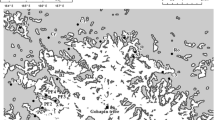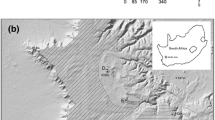Summary
The speciesFormica aquilonia andF. lugubris of the mound-building red wood ants have a disjunct boreoalpine distribution in Europe. The populations ofF. aquilonia in Finland, Switzerland and the British Isles show little genetic differentiation, whereas the populations ofF. lugubris show considerable differentiation. The Central European populations morphologically identified asF. lugubris can be genetically divided into two groups (here called types A and B). Type B is found in the Alps and the Jura mountains, and is genetically inseparable fromF. aquilonia. Type A lives sympatrically with type B in the Jura mountains and is also found in the British Isles. Sympatry of the two types in the Jura shows that these are separate species. It remains open whether type B is morphologically atypicalF. aquilonia or whether it is a separate species, perhaps with a past history of introgression betweenF. aquilonia andF. lugubris. The gene frequencies in the Finnish populations ofF. lugubris differ from those of both types A and B. Genetic differences withinF. lugubris indicate that the populations have evolved separately for a long time. The social structure ofF. lugubris colonies also shows geographic variation. The nests in Finland and the British Isles seem to be mainly monogynous and monodomous, whereas the nests in Central Europe are polygynous and form polydomous colonies.F. aquilonia has polygynous and polydomous colonies in all populations studied.
Similar content being viewed by others
References
Betrem, J. G., 1960. Über die Systematik derFormica rufa Gruppe.Tijdschr. Entomol. 103:51–81.
Breen, J., 1977. The distribution ofFormica lugubris Zett. (Hym. Formicidae) in Ireland with a discussion of its possible introduction.Ir. Nat. J. 19:123–127.
Cherix, D., 1980. Note préliminaire sur la structure, la phénologie et le régime alimentaire d'une super-colonie deFormica lugubris Zett.Ins. Soc. 27:226–236.
Cherix, D., 1983. Intraspecific variations of alarm pheromones between two populations of the red wood antFormica lugubris Zett. (Hymenoptera, Formicidae).Mitt. Schweiz. Entomol. Ges. 56:57–65.
Cherix, D., D. Chautems, D. J. C. Fletcher, W. Fortelius, G. Gris, L. Keller, L. Passera, R. Rosengren, E. L. Vargo and F. Walter, 1991. Alternative reproduction strategies inFormica lugubris Zett. (Hymenoptera, Formicidae).Ethol. Ecol. Evol. Special Issue 1:61–66.
Collingwood, C. A., 1964. The identification and distribution of British ants.Trans. Soc. Brit. Entomol. 16:93–121.
Douwes, P., 1981. Intraspecific and interspecific variation in workers of theFormica rufa group (Hymenoptera: Formicidae) in Sweden.Entomol. Scand. Suppl. 15:213–223.
Dunn, G. and B. S. Everitt, 1982.An introduction to mathematical taxonomy. Cambridge Univ. Press, Cambridge, 152 pp.
Felsenstein, J., 1985. Confidence limits on phylogenies: An approach using the bootstrap.Evolution 39:783–791.
Gösswald, K., G. Kneitz and G. Schirmer, 1965. Die geographische Verbreitung der hügelbauenden Formica-Arten (Hym., Formicidae) in Europa.Zool. Jahrb. Syst. 92:369–404.
Gris, G. and D. Cherix, 1977. Les grandes colonies de fourmis des bois du Jura (groupeFormica rufa).Mitt. Schweiz. Entomol. Ges. 50:249–250.
Hauschtek-Jungen, E. and H. Jungen, 1976. Ant chromosomes I. The genusFormica.Ins. Soc. 23:513–524.
Kutter, H., 1977. Hymenoptera, Formicidae.Insecta Helvetica 6:1–298.
Nei, M., 1987.Molecular evolutionary genetics. Columbia Univ. Press, New York, 512 pp.
Pamilo, P., 1982. Genetic population structure in polygynousFormica ants.Heredity 48:95–106.
Pamilo, P., 1984. Genotypic correlation and regression in social groups: multiple alleles, multiple loci and subdivided populations.Genetics 107:307–320.
Pamilo, P., 1987. Population genetics of theFormica rufa group. In:Chemistry and biology of social insects (J. Eder and H. Rembold, Eds), Verlag J. Peperny, München, pp. 68–70.
Pamilo, P., 1989. Estimating relatedness in social groups.Trends Ecol. Evol. 4:353–355.
Pamilo, P., 1990a. Statistical tests of phenograms based on genetic distances.Evolution 44:689–697.
Pamilo, P., 1990b. Comparison of relatedness estimators.Evolution 44:1378–1382.
Pamilo, P. and R. Rosengren, 1984. Evolution of nesting strategies of ants: genetic evidence from different population types ofFormica ants.Biol. J. Linn. Soc. 21:331–348.
Pamilo, P., R. Rosengren, K. Vepsäläinen, S. Varvio-Aho and B. Pisarski, 1978. Population genetics ofFormica ants I. Patterns of enzyme gene variation.Hereditas 89:233–248.
Pamilo, P., K. Vepsäläinen, R. Rosengren, S. Varvio-Aho and B. Pisarski, 1979. Population genetics ofFormica ants II. Genic differentiation between species.Ann. Entomol. Fenn. 45:65–76.
Rosengren, M., R. Rosengren and V. Söderlund, 1980. Chromosome numbers in the genusFormica with special reference to the taxonomical position ofFormica uralensis Ruzsk. andFormica truncorum Fabr.Hereditas 92:321–325.
Rosengren, R. and D. Cherix, 1980. The pupa-carrying test as a taxonomic tool in theFormica rufa group. In:Biosystematics of social insects (P. E. Howse and J.-L. Clement, Eds), Academic Press, New York, pp. 263–281.
Rosengren, R. and P. Pamilo, 1983. The evolution of polygyny and polydomy in mound-buildingFormica ants.Ada Entomol. Fenn. 42:65–77.
Rosengren, R., L. Sundström and W. Fortelius, (in prep) Monogyny and polygyny ofFormica ants - a result of alternative dispersal tactics? In:Queen number and social insects (L. Keller and D. Cherix, Eds)
Ross, K. G. and J. M. Carpenter, 1991. Phylogenetic analysis and the evolution of queen number in eusocial Hymenoptera.J. Evol. Biol. 4:117–130.
Seifert, B., 1991. The phenotypes of theFormica rufa complex in East Germany.Abh. Ber. Naturkundemus. Görlitz 65:1–27
Sundström, L., 1989. Genetic relatedness and population structure inFormica truncorum.Actes Coll. Insectes Soc. 5:93–100.
Tegelström, H., G. Nilsson and P.-I. Wyöni, 1983. Lack of species differences in isoelectric focused proteins in theFormica rufa group (Hymenoptera, Formicidae).Hereditas 98:161–165.
Ter Braak, C. J. F., 1988.CANOCO. Groep Landbouwwiskunde, Wageningen, 95 pp.
Ward, P. S., 1989. Genetic and social changes associated with ant speciation. In:The genetics of social evolution (M. D. Breed and R. E. Page Jr, Eds), Westview Press, pp. 123–148.
Yarrow, I. H. H., 1955. The British ants allied toFormica rufa (Hym., Formicidae).Trans. Soc. Brit. Entomol. 12:1–48.
Author information
Authors and Affiliations
Rights and permissions
About this article
Cite this article
Pamilo, P., Chautems, D. & Cherix, D. Genetic differentiation of disjunct populations of the antsFormica aquilonia andFormica lugubris in Europe. Ins. Soc 39, 15–29 (1992). https://doi.org/10.1007/BF01240528
Received:
Revised:
Accepted:
Issue Date:
DOI: https://doi.org/10.1007/BF01240528




